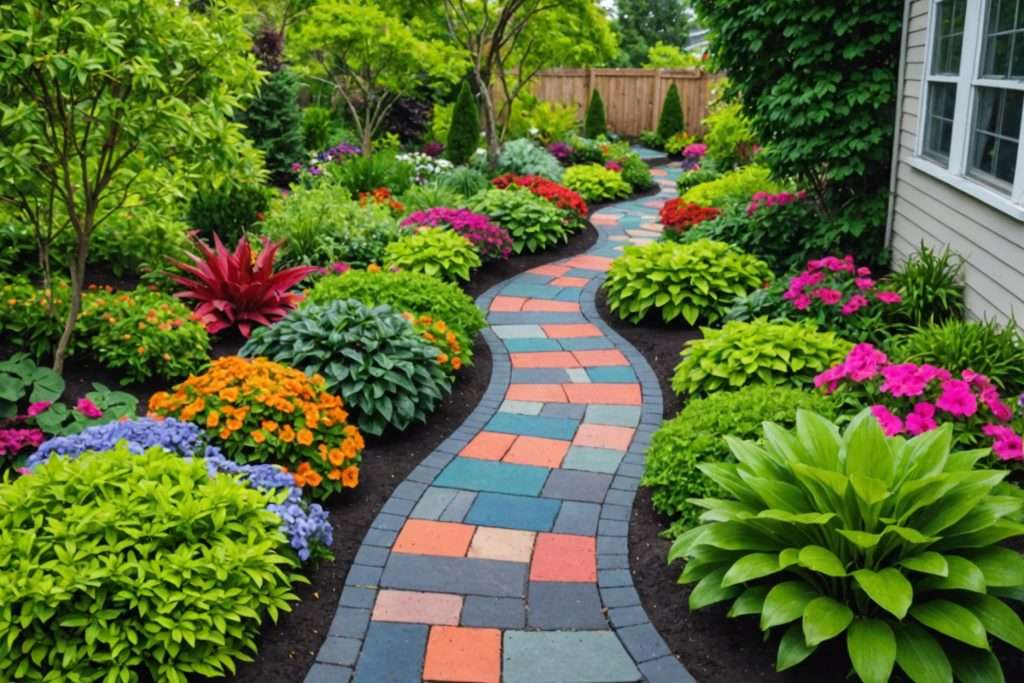
14 Innovative Ideas for Paver Pathways
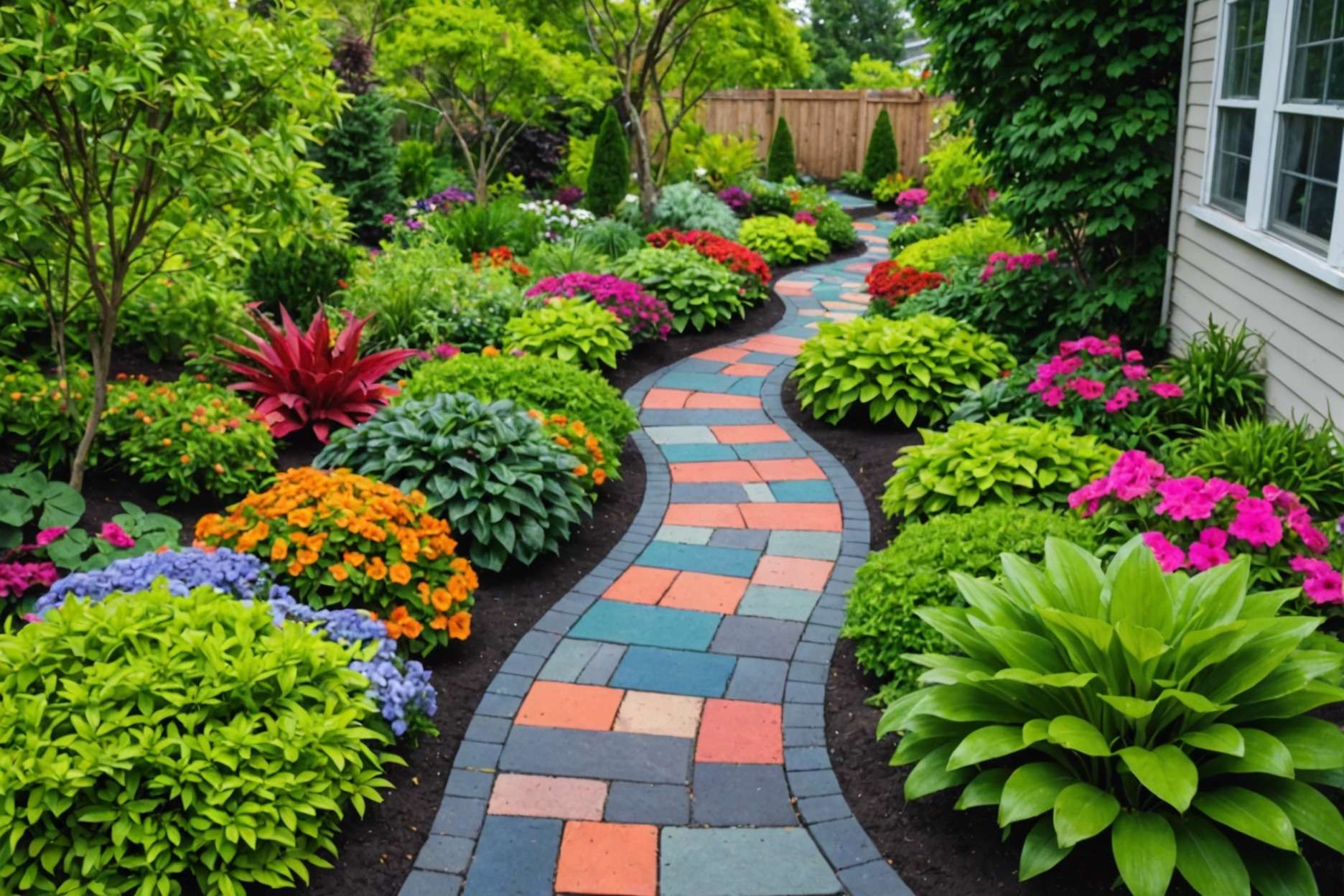
Explore a variety of innovative paver pathway ideas like classic brick layouts, modern concrete designs, and eco-friendly options using recycled materials. Enhance the aesthetic and functionality of your walkways with mixed materials, LED lighting, or border-lined paths to create a stunning and sustainable outdoor space.
Idea 1: Classic Brick Layout
Explore the timeless charm of brick pathways, perfect for creating a traditional or rustic look in your outdoor spaces. Here are some key ideas:
- Herringbone Pattern: Bricks are laid at 90-degree angles forming a zigzag pattern. This not only looks attractive but also offers excellent durability.
- Basketweave Pattern: This involves laying pairs of bricks at 90 degrees to each other, giving the appearance of a woven texture. It’s visually engaging and suits various outdoor styles.
- Materials: You can choose from red brick, brick pavers, or faux brick options, depending on your budget and design preference.
- Costs: Prices vary from $0.5 to $3.5 per brick. Professional installation typically ranges from $8 to $15 per square foot, increasing with more complex patterns.
- Installation Tips: For a long-lasting pathway, ensure the bricks are laid over a well-compacted base to prevent shifting and settling.
- Maintenance: Regular cleaning and occasional resealing will keep your brick pathway looking fresh and vibrant for years.
These patterns not only add visual interest but also enhance the strength of the pathway, making it a practical choice for high-traffic areas.
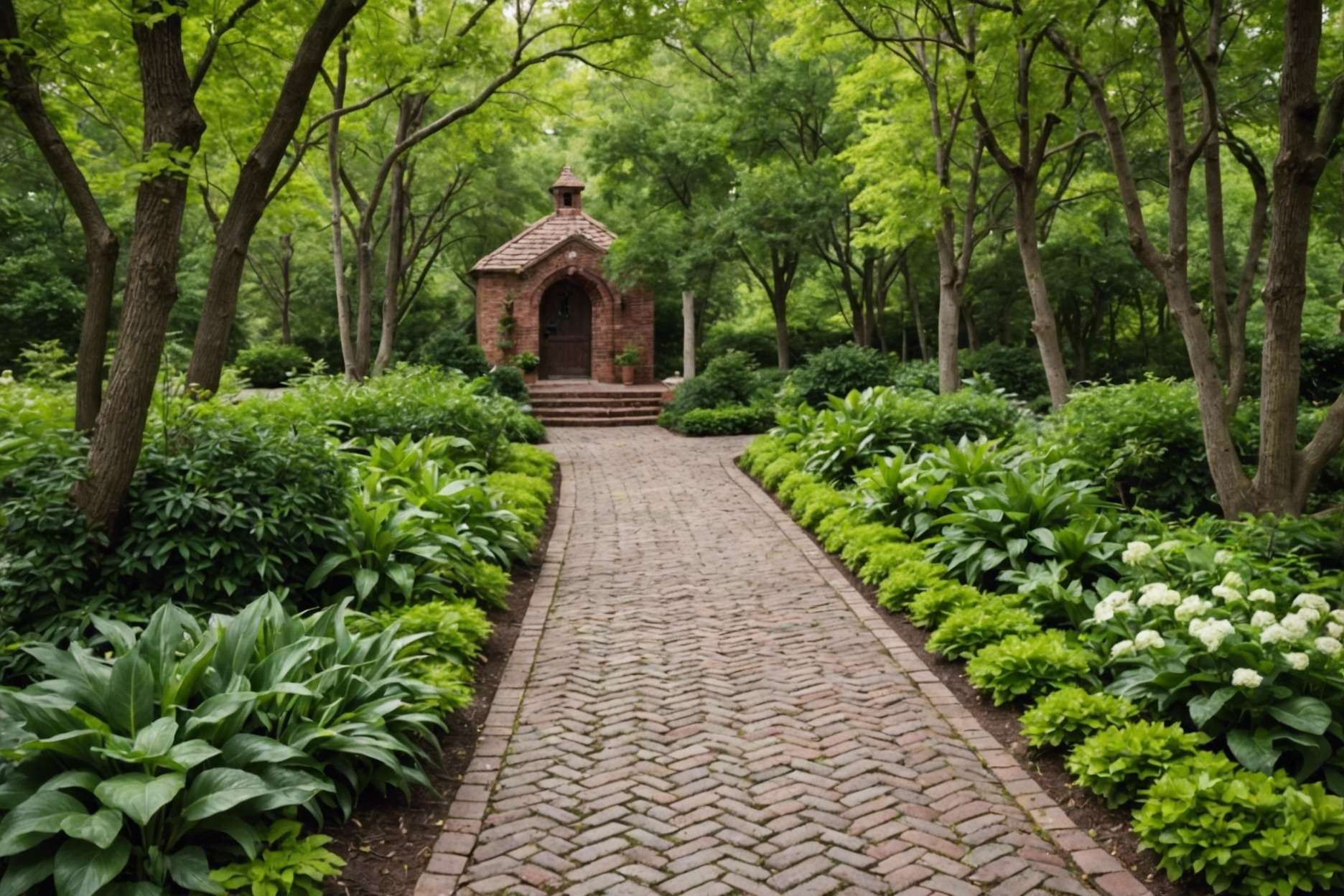
Idea 2: Modern Concrete Pavers
- Large-format concrete pavers are becoming a popular choice in modern landscape designs. Influenced by European and Mediterranean styles, these pavers help make smaller outdoor spaces look bigger and more open.
- Homeowners with contemporary homes prefer large pavers for their clean lines and minimalist aesthetics. Brands like Belgard offer various styles, including Mega-Arbel and Mirage Porcelain Pavers, which mimic the look of natural stone.
- Concrete pavers are a budget-friendly alternative to natural stone. They fit well with modern design trends that feature stark colors and sleek lines. Suitable for various applications, they can be used in patios, driveways, and even indoor spaces.
- Peacock Pavers crafts handcrafted concrete pavers that resemble natural stone. They are durable, low-maintenance, and eco-friendly. Available in colors like Buff, Dolphin Grey, and Rice White, these pavers can also be custom colored for large projects.
- These pavers come with additional trim pieces such as stair treads and wall caps, enhancing both indoor and outdoor settings.
Idea 3: Natural Stone Paths
Natural stone paths, like those made with slate or limestone, bring a touch of nature’s charm to any garden. These materials not only enhance the beauty of outdoor spaces but also blend seamlessly with the surrounding landscape. Here’s how to create a stunning natural stone path:
- Choosing Your Stone: Flagstone is popular for its varied shapes and natural look. Consider stones that complement your garden’s color palette and texture.
- Preparation: Start by laying out your path. Remove any grass and create a stable base by excavating the area slightly and adding a layer of sand.
- Installation: Place the stones on the sand base, ensuring they are stable and level. Use landscape fabric underneath to prevent weed growth.
- Finishing Touches: Fill the gaps between stones with sand, gravel, or even hardy ground-cover plants that can withstand foot traffic. This adds to the path’s natural look and helps keep the stones in place.
Each type of stone walkway has its unique appeal. For instance, limestone offers a refined look, while slate provides a more rustic feel. Mixing different stone types and sizes can create a captivating, one-of-a-kind pathway. Embrace natural imperfections in the stones to enhance the pathway’s organic appearance.
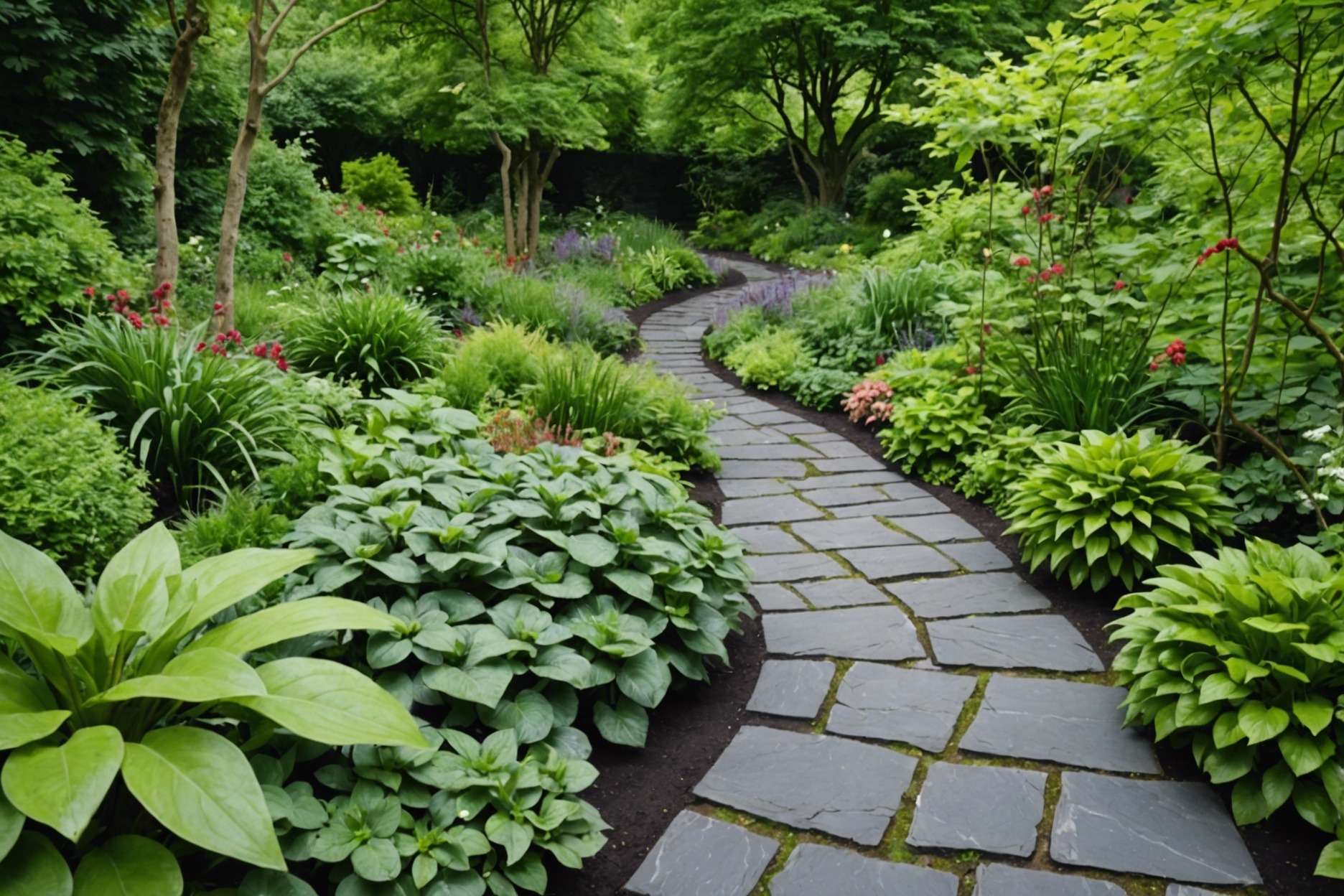
Idea 4: Mosaic Pebble Walkways
Mosaic pebble walkways offer a creative way to enhance your garden paths with unique, eye-catching designs. These walkways combine artistic flair with functionality, preventing damage to garden areas while boosting aesthetic appeal. Here’s how you can create these beautiful paths:
- Starting Your Pathway: First, outline your path and remove any grass and soil. Compact the base with crushed stone and cover it with landscape fabric for stability. Secure the edges with durable edging material.
- Creating the Mosaic: Sort your pebbles by color and size. Draft a design on paper to guide your layout. Lay a mortar base and arrange the pebbles following your design. Use plywood to press the stones into place and ensure an even surface.
- Design Patterns: Choose from various patterns like:
- Galaxy Swirls: Mix dark cobbles with colored ceramic shards to mimic the night sky.
- Centered Spiral: Create a striking spiral using uniformly sized pebbles.
- Star Struck: A bright white star surrounded by dark stones.
- Stone Carpet: A free-form design bordered by a ring of bricks.
- Finishing Touches: Keep the mortar moist for a few days to harden properly. Clean any mortar residue from the pebbles with hydrochloric acid, followed by a thorough rinse with water.
These mosaic pebble pathways not only add charm to your garden but also allow you to express your creativity through various intricate designs. Whether you choose geometric shapes, natural scenes, or abstract patterns, these pathways can transform your outdoor space.
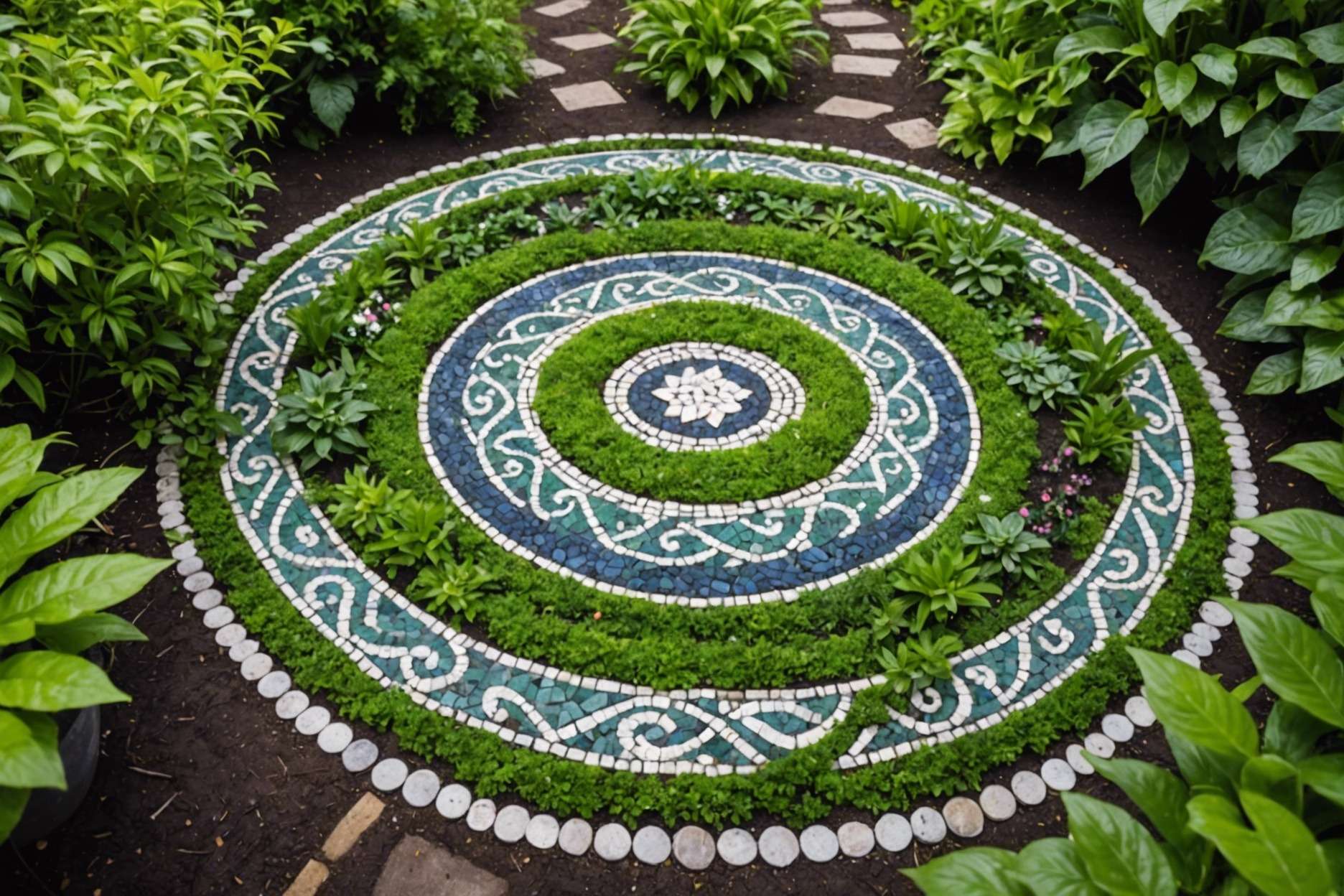
Idea 5: Grass Joint Pavers
Grass joint pavers blend the charm of greenery with the structure of stone pathways. They work perfectly in cottage-style gardens by creating a natural, yet organized look. Here’s how to incorporate grass joints into your paver pathway:
- Base Preparation: Start by clearing the pathway area. Use pea gravel or decomposed granite as a base to ensure proper drainage and stability.
- Laying Pavers: Place your chosen pavers—stone or interlocking types are both great choices. Leave enough space between them to allow grass to grow. Typically, a few inches between each paver should suffice.
- Grass Installation: Once your pavers are set, fill the gaps with soil and plant grass seeds or lay sod. This will require regular watering until the grass establishes.
- Maintenance: Grass joint pavers need mowing and watering just like any lawn area. Keep the grass healthy to maintain the beautiful look of your pathway.
This method not only enhances the beauty of your garden pathways but also helps in soil erosion control, making it a practical choice for sloped areas. Choose grass that matches your local climate for best results.
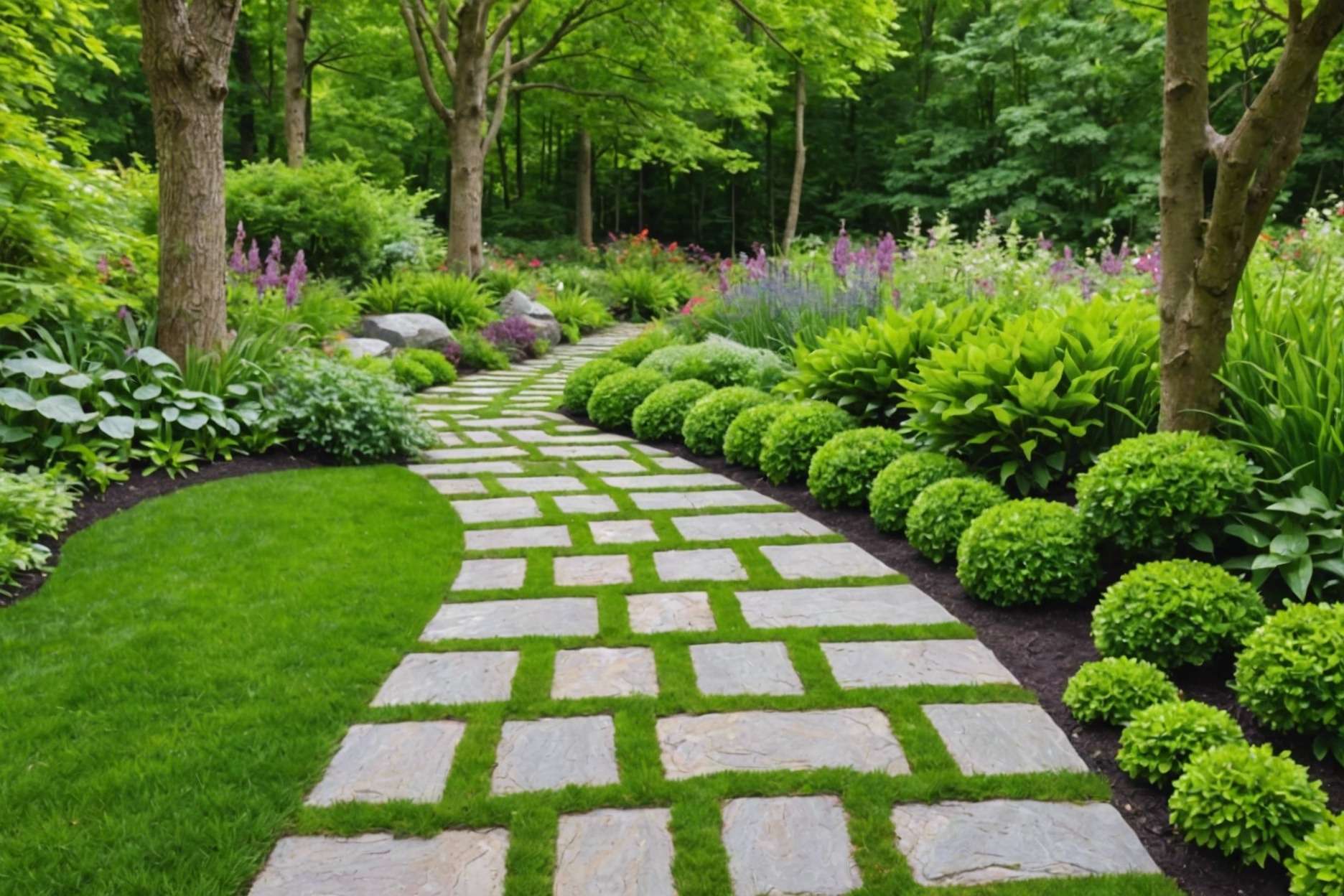
Idea 6: Recycled Material Tracks
Recycled material tracks are a smart and sustainable choice for pathway construction. They use materials that might otherwise end up in landfills, helping to reduce environmental impact. Here are some top eco-friendly materials to consider:
- Recycled Glass: Turns waste glass into beautiful, durable pavers.
- Recycled Rubber: Made from old tires, these pavers are soft and perfect for walking paths.
- Bamboo: A strong, fast-growing alternative to traditional wood.
- Recycled Plastic: Durable and weather-resistant, ideal for outdoor use.
- Recycled Steel: Strong and uses less energy than making new steel.
- Reclaimed Wood: Offers a unique look and enhanced durability.
Using these materials not only supports sustainability but also adds a unique aesthetic to any project.
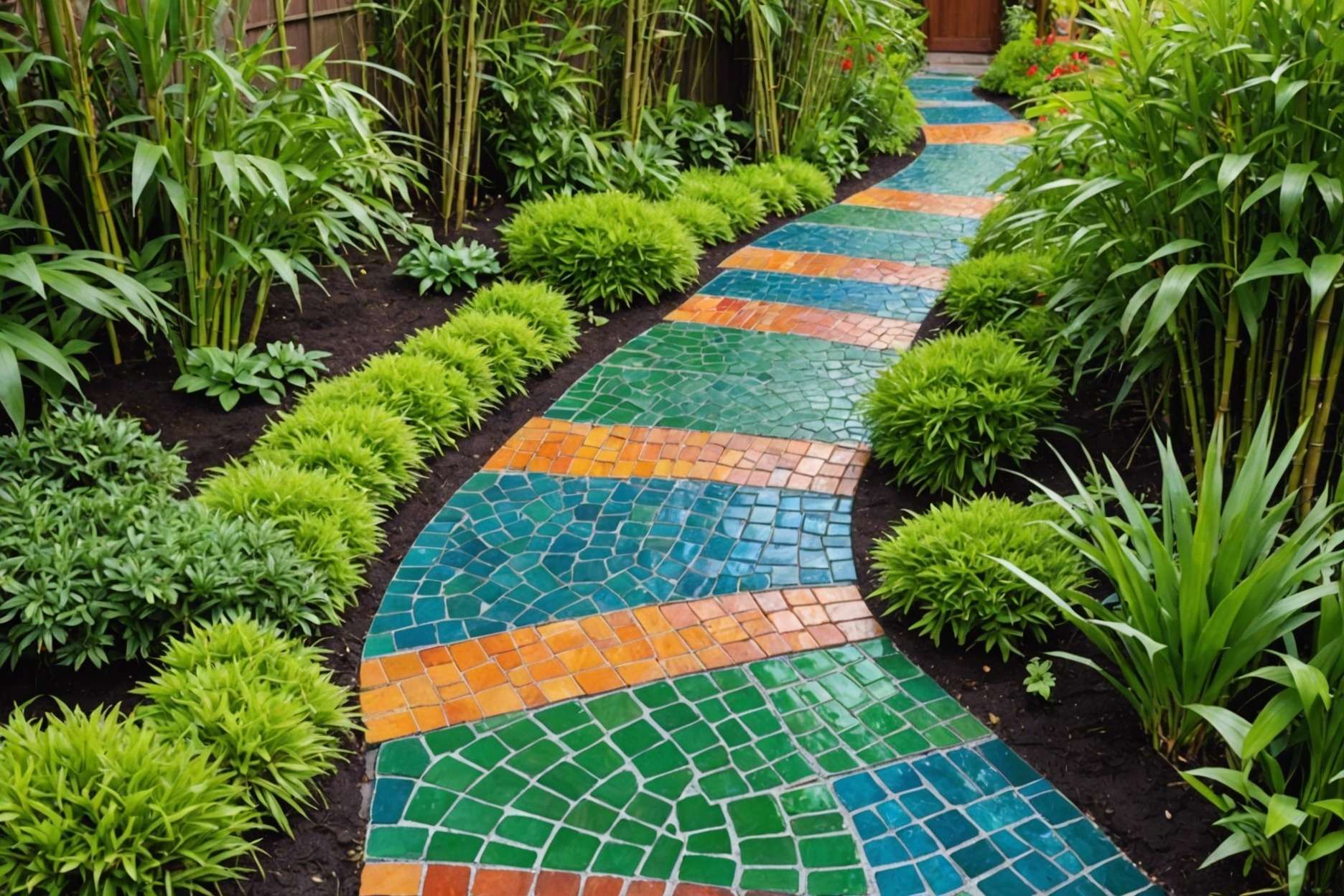
Idea 7: LED-Lit Walkways
Integrating LED lighting into paver pathways not only enhances the safety of your outdoor spaces but also boosts their aesthetic appeal. Here’s how you can use LED lights effectively:
- Safety and Visibility: Install in-ground lights along the edges of walkways to provide subtle, non-glare illumination. This helps in minimizing visibility issues and ensures a safe path in low light conditions.
- Aesthetic Appeal: Choose lighting that complements the design of your paver walkways. Bollard lights work well for larger areas and double as decorative elements. Opt for light fixtures with color temperatures that create the desired ambiance.
- Types of Lights:
- Well Lights
- Bullet Lights
- Focusable Lights
- Step Lights
- Strip Lights
- Swivel Lights
- Installation Tips: While you can install these lights as a DIY project, professional installation is recommended for the best safety and visual outcome. Ensure the fixtures are nearly flush with the paver surface to maintain a clean look.
- Maintenance and Upgrades: Opt for professional maintenance to prolong the life and efficiency of your lighting fixtures. Future trends in outdoor lighting lean towards more energy-efficient and advanced options, like smart lighting systems and solar-powered units.
- Cost Considerations: The cost varies based on the project size and complexity. A basic setup might start around $600, while extensive systems can exceed $5,000.
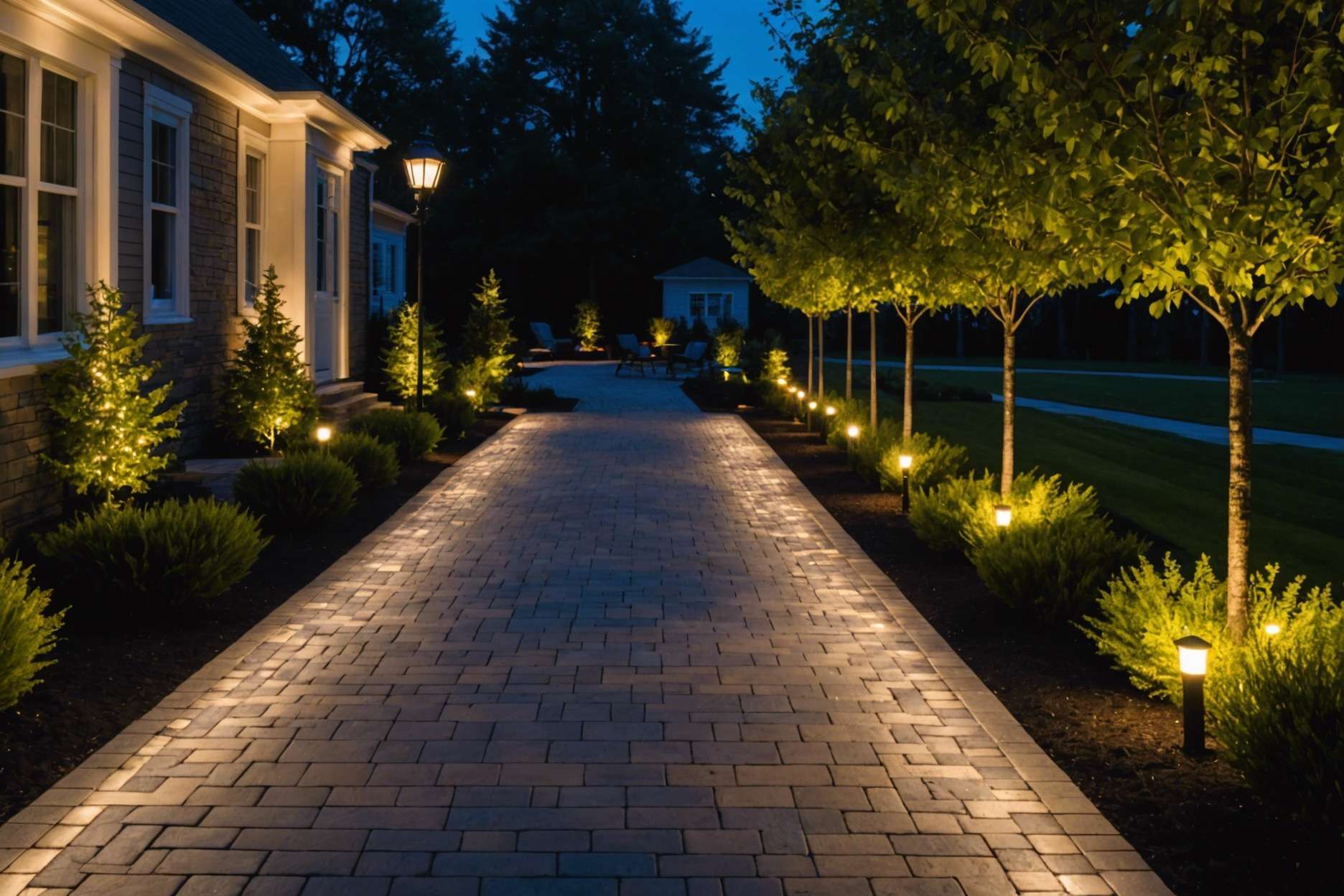
Idea 8: Permeable Paver Systems
Permeable pavers are a smart choice for managing rainwater in your landscape. They allow water to soak through, reducing runoff and preventing flooding. This helps replenish groundwater and reduces strain on city drainage systems.
- Environmental Benefits: Permeable pavers filter pollutants from runoff, contributing to cleaner water sources. They combat the urban heat island effect by keeping the ground cooler, which supports local ecosystems and reduces greenhouse gases.
- Practical Benefits: These pavers are durable and can handle heavy loads, making them great for high-traffic areas. They’re also low-maintenance since they resist dirt build-up and don’t need regular sealing.
- Aesthetic and Versatile: With a variety of colors, shapes, and textures available, permeable pavers enhance the visual appeal of any space. They’re used in driveways, patios, and walkways, blending beautifully with natural surroundings.
- Sustainability: By reducing heat, preventing soil erosion, and managing stormwater effectively, permeable pavers are a sustainable solution to urban water management challenges. They add value to your property while promoting environmental health.
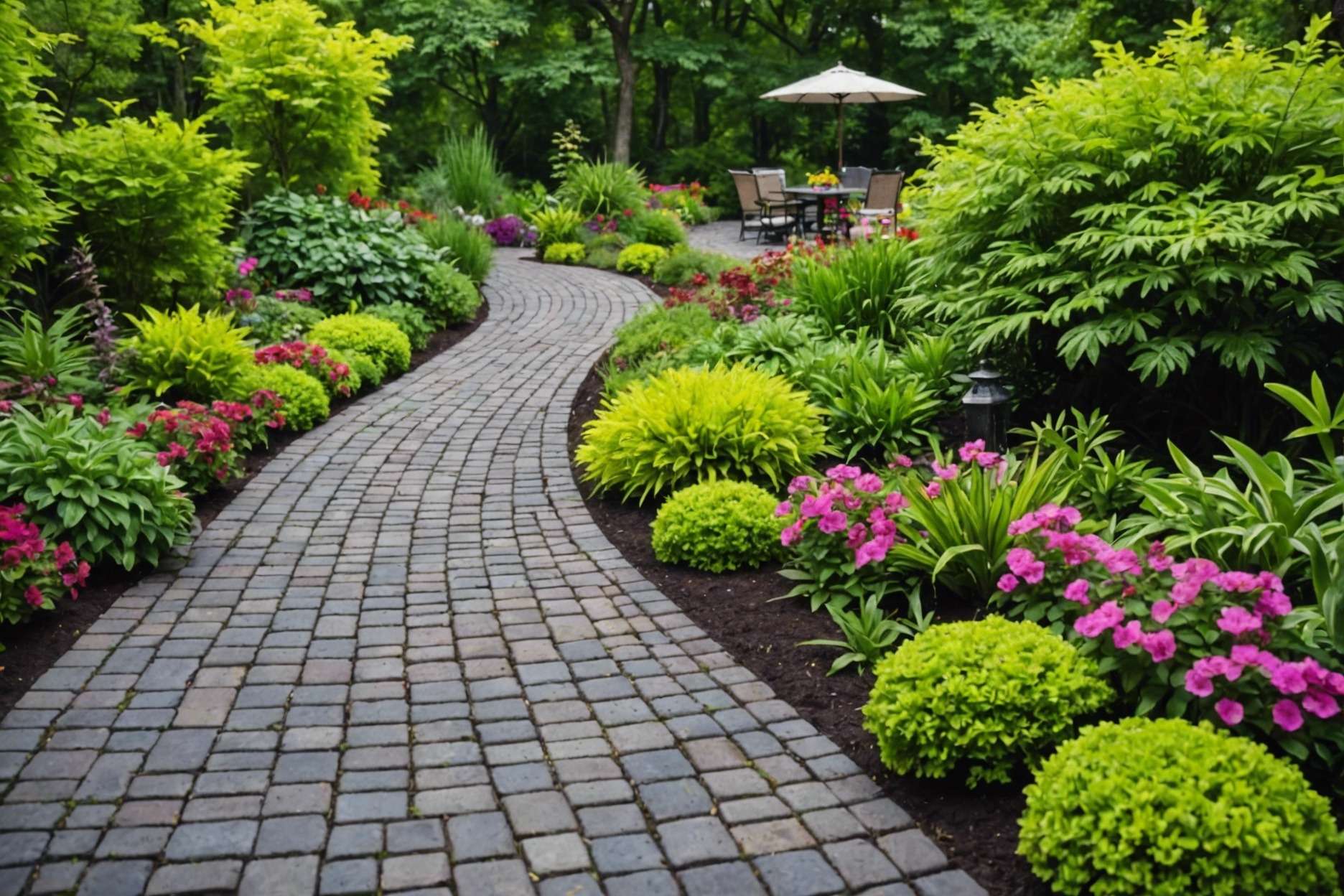
Idea 9: Stepping Stones in Gravel
Scatter stepping stones across a bed of contrasting gravel to create a charming, informal pathway in your garden. This design not only looks great but is also practical, guiding visitors along your garden spaces.
- Materials Needed: Choose from a variety of stepping stones like river rocks, concrete, or red brick. Pair these with fine or coarse gravel depending on your preference.
- Installation Steps for Gravel Pathways:
- Lay out your stepping stones to determine spacing and arrangement.
- Prepare the base by clearing the pathway area and applying a mortar mix for stability.
- Set each stone, ensuring they are level and secure.
- Attach a string line to maintain straight lines and consistent spacing.
- Once all stones are laid, fill around them with gravel, securing them further and enhancing the pathway’s appearance.
For maintenance, regularly check the stones and gravel for any shifts or settling, and replenish gravel as needed to keep the pathway clear and visually appealing.
Explore different designs like organic shapes or geometric patterns to add a unique touch to your garden. This project is suitable for DIY enthusiasts looking for an affordable upgrade to their outdoor space.
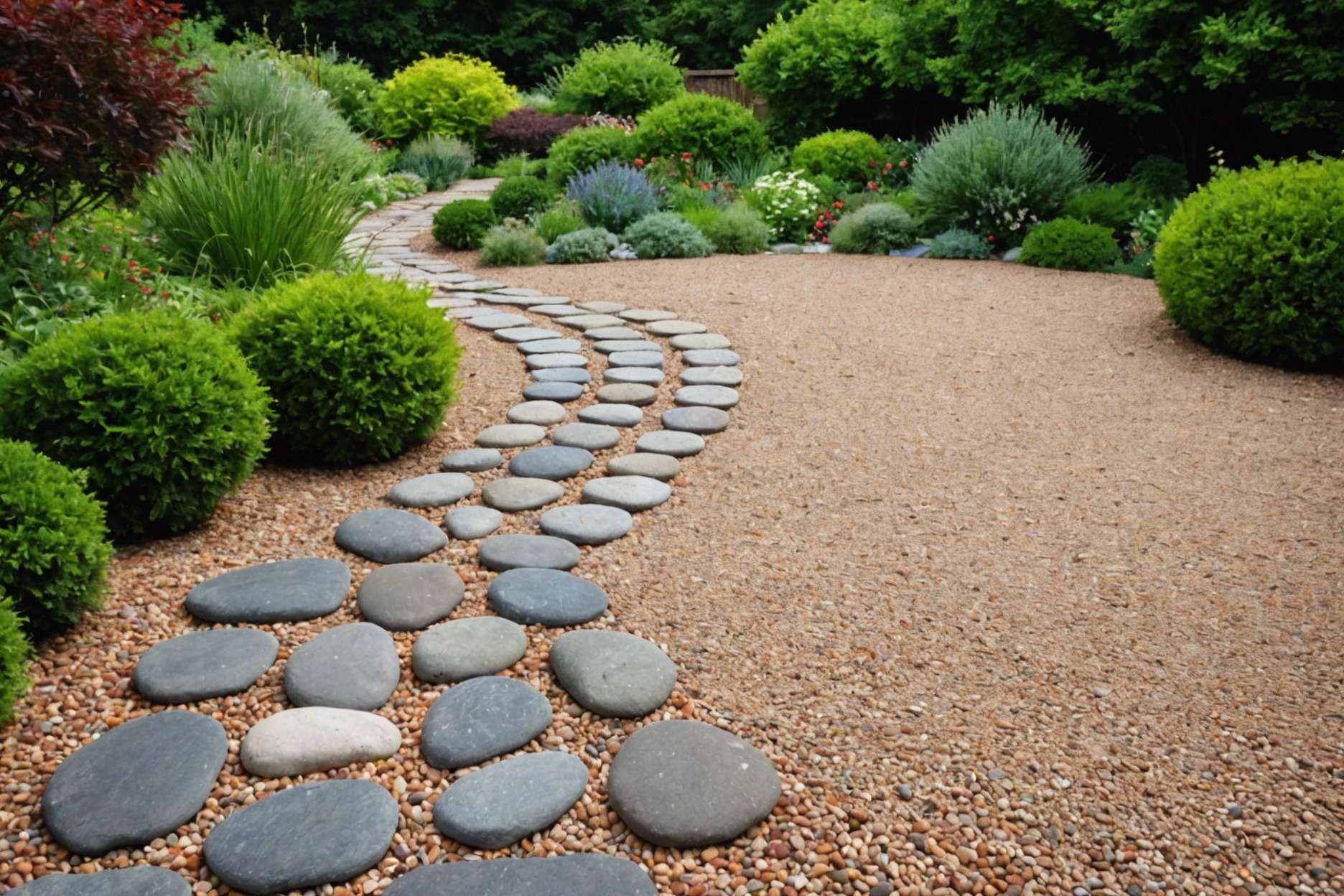
Idea 10: Checkerboard Pattern Pavers
Checkerboard pattern pavers create a striking visual impact in any garden setting. This design works well in both traditional and contemporary outdoor spaces. Here’s a simple guide on how to implement this elegant feature:
- Choose Your Colors: Select two different colors of pavers to enhance the checkerboard effect.
- Plan the Layout: Arrange your pavers in a straight line for the first row, then offset each subsequent row to create the checkerboard pattern.
- Prepare the Base: Remove the turf where each paver will go, and dig down about 100mm. Fill this with a mix of cement and brickie’s sand.
- Set the Pavers: Place each paver in the prepared base, ensuring they are level and straight.
- Finish Up: Once all pavers are set, wash them down to remove any excess mortar and bring out the color of the pavers.
This method not only adds a unique touch to your garden but also offers a practical, low-maintenance solution for beautiful and functional outdoor pathways.
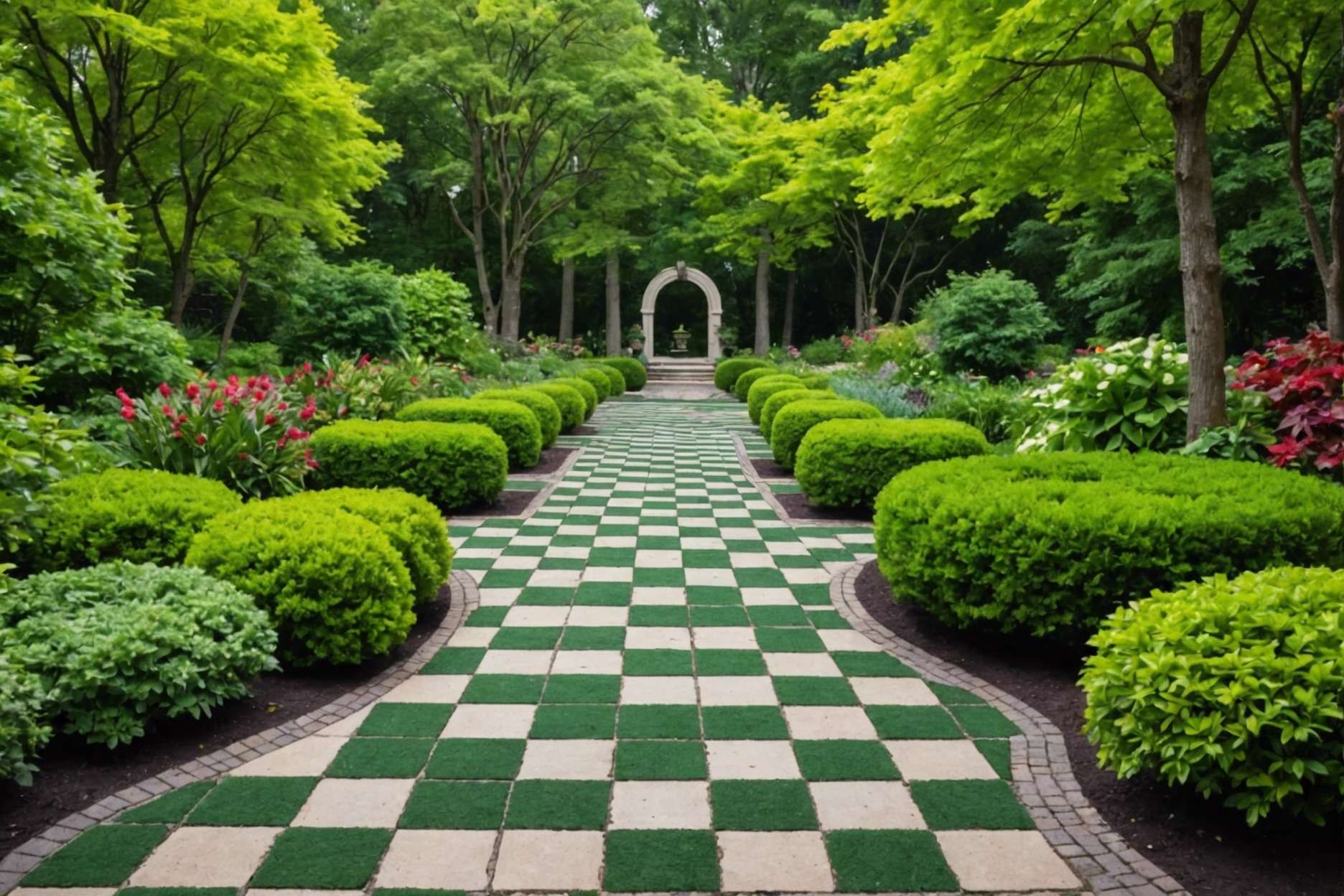
Idea 11: Curved and Winding Paths
Curved and winding garden paths not only enhance the beauty of your outdoor space but also invite exploration and adventure. They guide visitors through different sections of the garden, creating a dynamic experience that can’t be achieved with straight paths.
- Design Considerations: When planning a curved pathway, think about the natural flow of your garden. Use landscape marking chalk to outline potential routes, ensuring they feel organic and integrated. Consider the path’s width and curve radius to maintain a balance between aesthetics and functionality.
- Material Choices: For a harmonious look, select materials that complement your garden and home exterior. Options include:
- Stone pavers for a classic, durable walkway.
- Crushed limestone or pea gravel for a softer, rustic appearance.
- Stepping stones with ground cover plants in between for a natural look.
- Benefits: Curved paths can:
- Visually enlarge a small garden by drawing the eye along a meandering route.
- Highlight specific garden features or plantings as focal points along the way.
- Increase the sense of mystery and discovery, making every garden stroll an adventure.
Always ensure that the materials used are stable and safe for walking, with angular pieces that lock together to prevent shifting. This approach not only adds beauty but also functionality, making your garden paths as practical as they are picturesque.
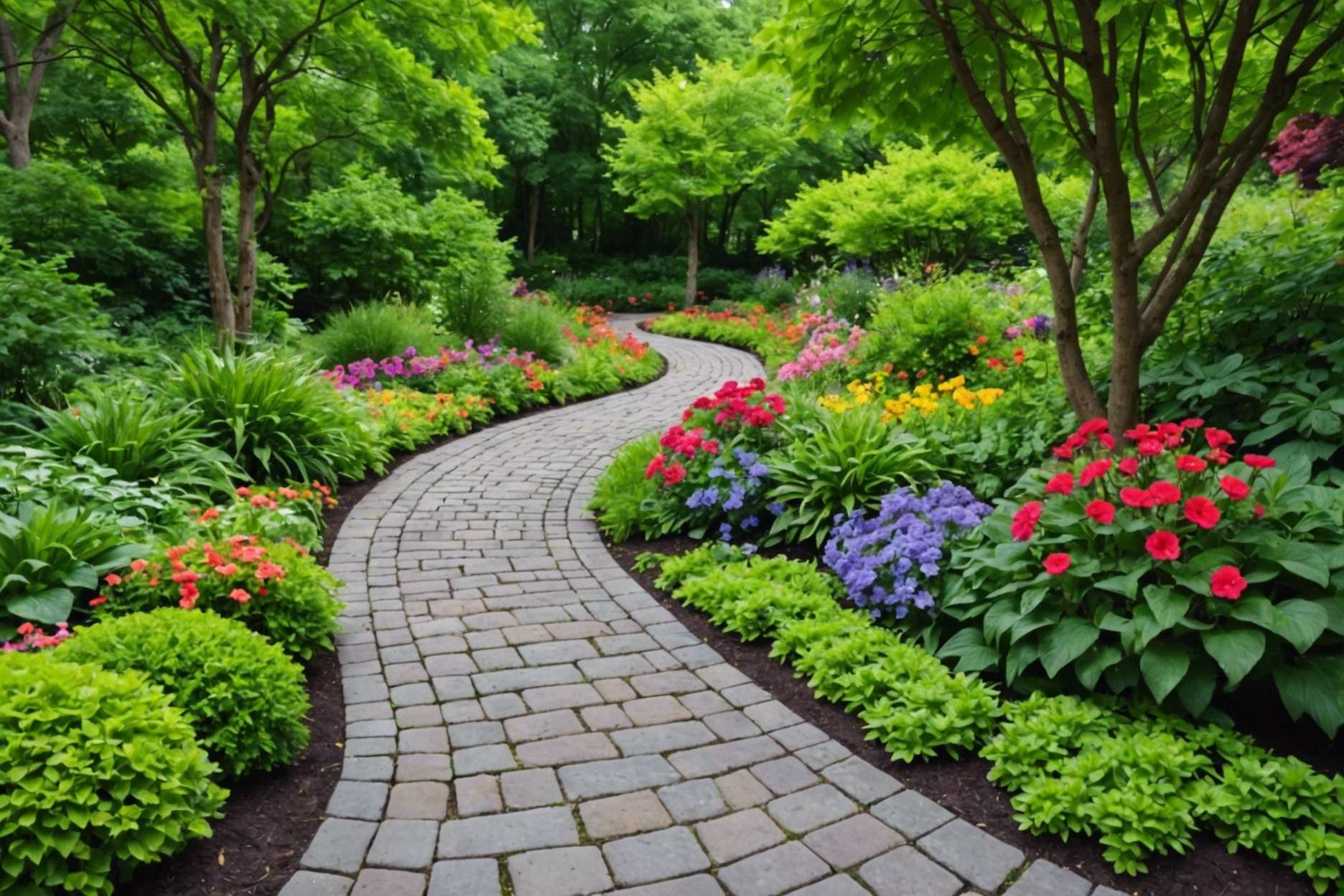
Idea 12: Solar Glow Pavers
Solar-powered pavers are the latest innovation in pathway design, offering not only aesthetic enhancement but also improved safety. These pavers absorb sunlight during the day and glow at night, providing up to eight hours of illumination. Ideal for both residential and commercial spaces, they can transform pool decks, walkways, and more.
- Safety and Aesthetics: The glow from these pavers enhances visibility, making outdoor areas safer and more navigable at night without harsh lighting.
- Durable Materials: The pavers resist solvents, motor oils, gasoline, and acids. They are also unaffected by de-icing salts, making them suitable for various climates and conditions.
- Color Options: Available in multiple colors such as Charcoal, Israel Pewter, Buff, and Pewter, allowing for customization to fit any design scheme.
- Standards Compliance: These pavers meet North American standards set by ASTM International and the CSA Group, ensuring high quality and durability.
These solar glow pavers are a practical yet stylish choice for enhancing outdoor spaces while ensuring safety and compliance with quality standards.
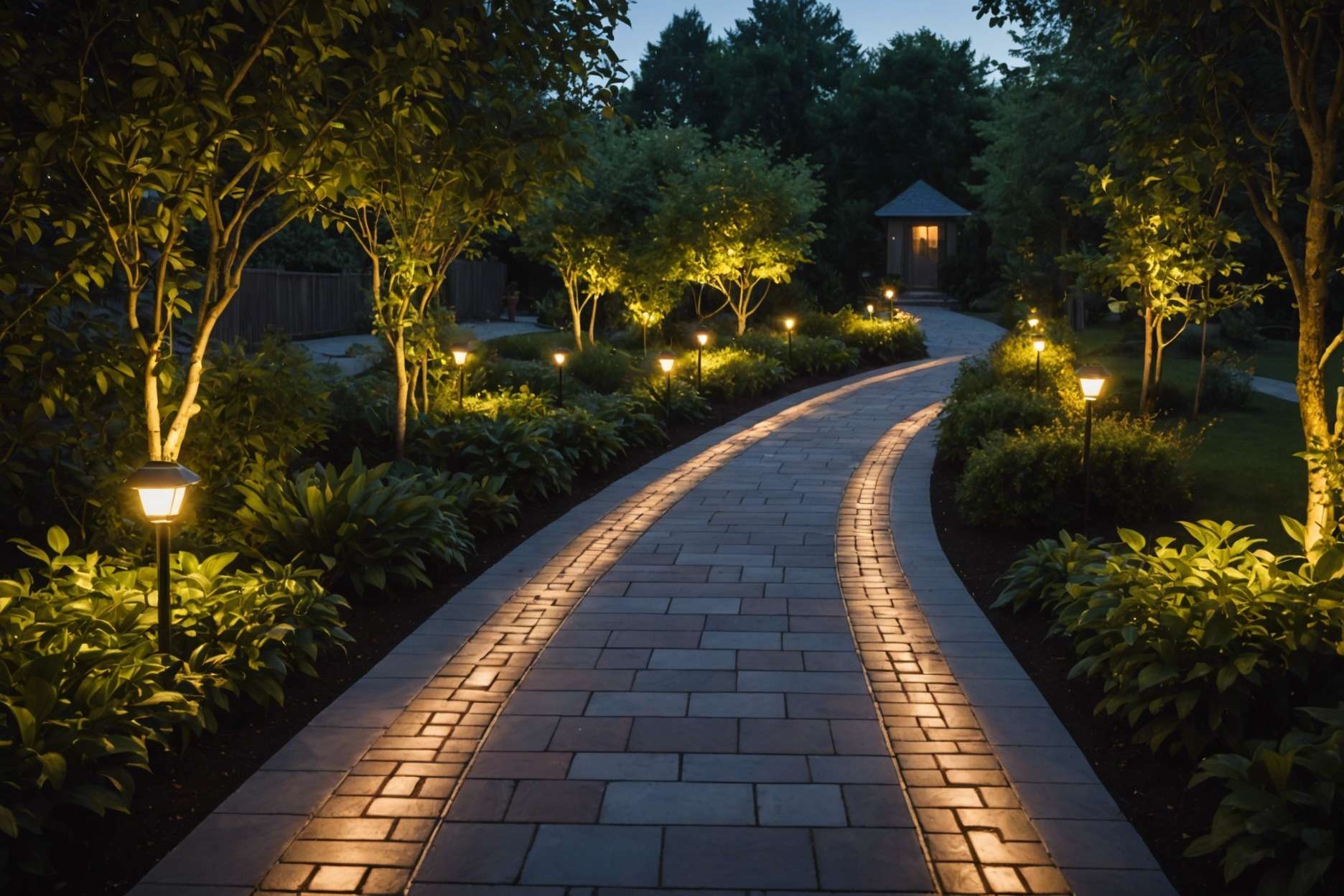
Idea 13: Mixed Material Pathways
Mixed material pathways blend different textures and colors to create visually appealing and unique garden paths. Here are some innovative ideas:
- Wood and Stone: Combine square wooden stepping stones with surrounding pebbles or mulch for a modern, contrasting look.
- Brick and Concrete: Use bricks to line or accentuate a predominantly concrete pathway, adding definition and style.
- Flagstone and Gravel: Lay flagstone with spaces filled in with gravel for a natural, flowing appearance.
- Stepping Stones and Grass: Place large stepping stones within a manicured lawn for a clean and simple path.
These combinations not only enhance the aesthetic of your outdoor space but also cater to varying styles and preferences. Whether you prefer a rustic feel or a modern design, using mixed materials can achieve the desired effect while providing functional walkways in your garden.
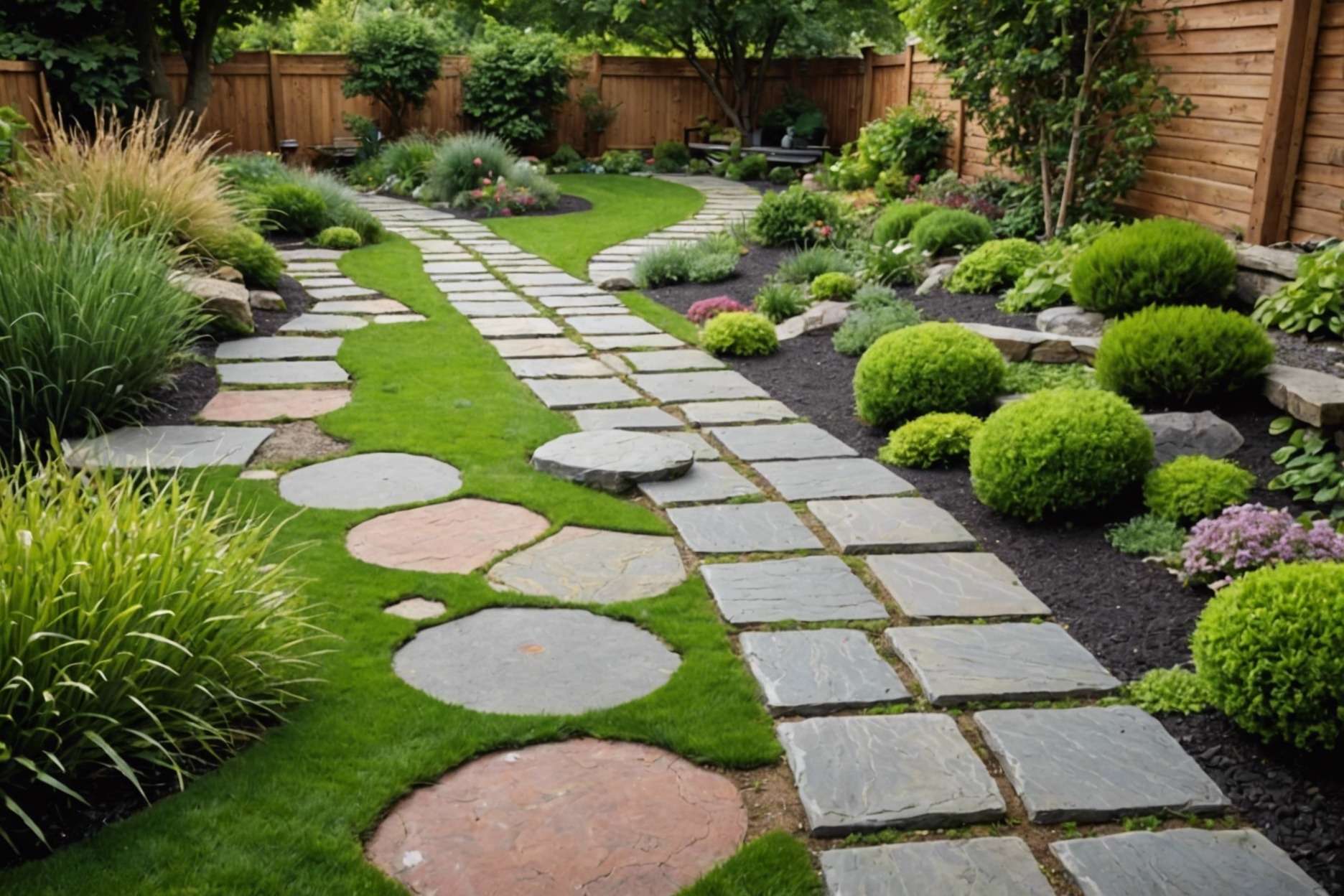
Idea 14: Border-Lined Paths
Enhancing paver pathways with creative borders not only defines your walkway but also elevates the overall design. Here are some innovative ideas:
- Metal Edging: Metal borders provide a sleek, modern look and are durable. They help maintain the shape of the pathway and prevent the pavers from shifting.
- Plant Borders: Lining your pathway with plants adds a natural touch and can attract wildlife such as butterflies and birds. Choose low-growing shrubs or perennial ground covers for a lush look.
- Contrasting Pavers: Use pavers in contrasting colors or textures to create a visually striking border. This technique highlights the path and makes it a focal point in your landscape.
For more on enhancing outdoor spaces, check our services on Patio Remodel and Pavers.
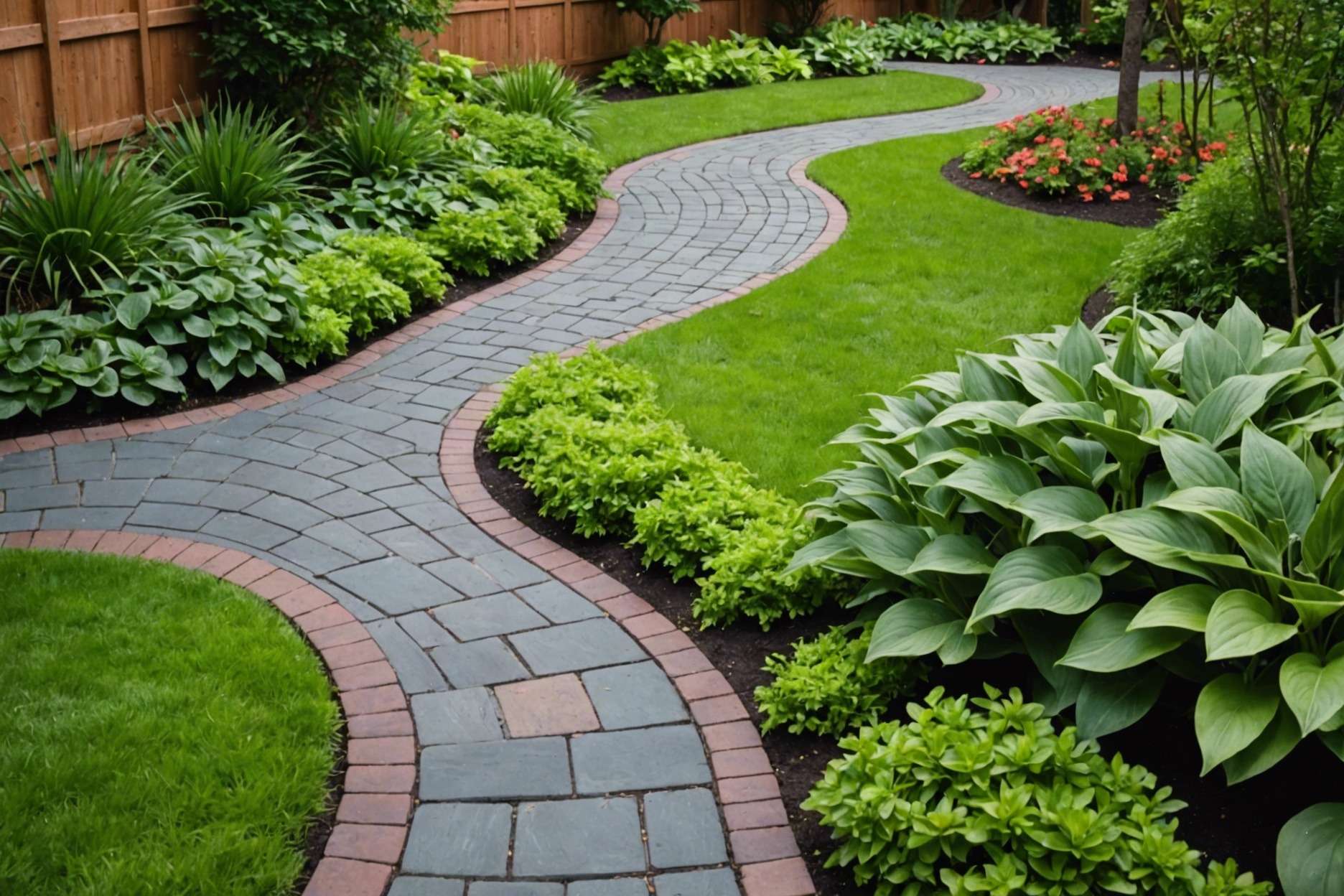
FAQ
What are some classic patterns for laying brick in a pathway?
Brick pathways can be laid in a variety of patterns to enhance both aesthetics and durability. Popular patterns include the herringbone pattern, where bricks are laid at 90-degree angles forming a zigzag pattern, and the basketweave pattern, which involves laying pairs of bricks at 90 degrees to each other to create a woven appearance.
Are concrete pavers a good choice for modern outdoor designs?
Yes, large-format concrete pavers are particularly popular in modern landscape designs due to their clean lines and minimalist aesthetics. They are suitable for a variety of applications including patios and driveways, and can mimic the look of natural stone.
How can I ensure the durability of a natural stone path?
To ensure the durability of a natural stone path, start with a stable base of excavated area and sand. Use landscape fabric underneath the stones to prevent weed growth, and fill gaps between stones with sand, gravel, or ground-cover plants which help secure the stones and add to the path’s natural appearance.
What are some creative designs for mosaic pebble walkways?
Mosaic pebble walkways can feature various artistic designs like galaxy swirls, centered spirals, star struck patterns, or a stone carpet look. These designs are created by arranging pebbles on a mortar base following a pre-drafted design on paper.
How do grass joint pavers work?
Grass joint pavers involve laying stone or interlocking pavers with spaces between them for grass to grow, blending the stability of pavement with the natural beauty of grass. They require a base of pea gravel or decomposed granite for proper drainage and stability.
What materials are used in recycled material tracks for pathways?
Recycled material tracks can include a variety of eco-friendly materials such as recycled glass, recycled rubber from old tires, bamboo, recycled plastic, recycled steel, and reclaimed wood, which help in reducing environmental impact.
How can LED lighting enhance outdoor pathways?
Integrating LED lighting in paver pathways improves safety by enhancing visibility and adds aesthetic appeal. Options include in-ground lights for subtle illumination, and bollard lights which double as decorative elements.
What are the advantages of using permeable paver systems?
Permeable pavers help manage rainwater, reduce runoff, prevent flooding, and can handle heavy loads, making them suitable for high-traffic areas. They are also aesthetically versatile and sustainably manage stormwater.
Is it practical to use stepping stones in gravel for garden pathways?
Yes, stepping stones in gravel are not only aesthetically pleasing but also guide foot traffic and control gravel spread, offering a practical and informal pathway option for gardens.
How can I create a checkerboard pattern paver pathway?
To create a checkerboard pattern, select two different colors of pavers. Arrange them in alternating colors and offset each row to achieve the checkerboard effect, ensuring they are level and securely placed on a prepared base of cement and brickie’s sand.
Can curved and winding paths enhance garden dynamics?
Curved and winding paths add beauty and interest to outdoor spaces by guiding visitors through various garden areas and inviting exploration, especially when incorporating materials that complement the garden’s aesthetic.
How do solar glow pavers work?
Solar glow pavers absorb sunlight during the day and emit light at night, providing illumination for up to eight hours. They are made from materials resistant to various solvents and conditions, suitable for different climates.
What are some interesting mixed material combinations for pathways?
Interesting combinations for mixed material pathways include wood and stone, brick and concrete, flagstone and gravel, or stepping stones with grass, blending different textures and colors to create unique and appealing garden paths.
What border options can enhance the design of paver pathways?
Creative borders such as metal edging, plant borders, or contrasting paver colors can define and elevate the design of a pathway, with each option providing a unique aesthetic appeal and functional benefits like maintaining pathway shape and inviting natural elements.
